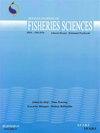Fatty acid composition of tench (Tinca tinca L., 1758): A seasonal differentiation
IF 0.6
4区 农林科学
Q3 FISHERIES
引用次数: 1
Abstract
Abstract Seasonal variations of proximate compositions and fatty acids of tench (Tinca tinca L., 1758) captured from Seyhan Dam Lake were investigated. The results showed that seasonal fatty acid compositions of tench fillets in July, August and November ranged from 29.59% to 33.71% saturated fatty acids (SFA), 20.50% to 21.69% monounsaturated fatty acids (MUFAs) and 26.50% to 41.85% polyunsaturated fatty acids (PUFAs). Lipid contents of tench fillets in all seasons were statistically different (p <0.05). The major fatty acids of tench sampled in different seasons were palmitic acid (16:0), stearic acid (18:0), palmitoleic acid (16:1ω7), oleic acid (18:1ω9), linoleic acid (LA, 18:2ω6), arachidonic acid (ARA, 20:4ω6), eicosapentaenoic acid (EPA, 20:5ω3) and docosahexaenoic acid (DHA, 22:6ω3). The proportions of DHA were ranged from 5.51% to 17.33%. DHA+EPA compositions of tench fillets were in the highest level as 22.47% in November. The highest ARA content was determined in November as 10.88%. The results showed that tench is a good protein and fatty acid source in human nutrition.藤本植物(Tinca Tinca L.,1758)的脂肪酸组成:季节分化
摘要研究了采自Seyhan Dam Lake的tench(Tinca Tinca L.,1758)的主要成分和脂肪酸的季节变化。结果表明,7月、8月和11月的tench鱼片的季节性脂肪酸组成为29.59%至33.71%的饱和脂肪酸(SFA)、20.50%至21.69%的单不饱和脂肪酸和26.50%至41.85%的多不饱和脂肪酸酯。不同季节tench鱼片的脂质含量差异有统计学意义(p<0.05),不同季节tench的主要脂肪酸为棕榈酸(16:0)、硬脂酸(18:0)、棕榈油酸(16:1ω7)、油酸(18:1ω9)、亚油酸(LA,18:2ω6)、花生四烯酸(ARA,20:4ω6),二十碳五烯酸(EPA,20:5ω3)和二十二碳六烯酸(DHA,22:6ω3)。DHA的比例在5.51%至17.33%之间。11月份,tench鱼片的DHA+EPA含量最高,为22.47%。11月测定的ARA含量最高,为10.88%。结果表明,tench是人体营养中良好的蛋白质和脂肪酸来源。
本文章由计算机程序翻译,如有差异,请以英文原文为准。
求助全文
约1分钟内获得全文
求助全文
来源期刊

Iranian Journal of Fisheries Sciences
FISHERIES-
CiteScore
2.30
自引率
11.10%
发文量
0
审稿时长
3 months
期刊介绍:
1- Living various species (contains animals and vegetal species) in various aquatic ecosystems.
2- Health and diseases of aquatic species.
3- Determining the stocks and specific time and location for catching and reliable exploitation for sustainable development.
4- Methods of propagation and culture of high value aquatic resources.
5- Aquatic stock assessment and the methods of restocking the high value species and suggestion for rate, areas and the time for releasing fish and other aquatic organisms fries.
6- Pollutant agents and their effects to the environments of aquatic species.
7- Feed and feeding in aquatic organisms.
8- Fish processing and producing new products.
9- The economic and social aspects of fisheries.
 求助内容:
求助内容: 应助结果提醒方式:
应助结果提醒方式:


